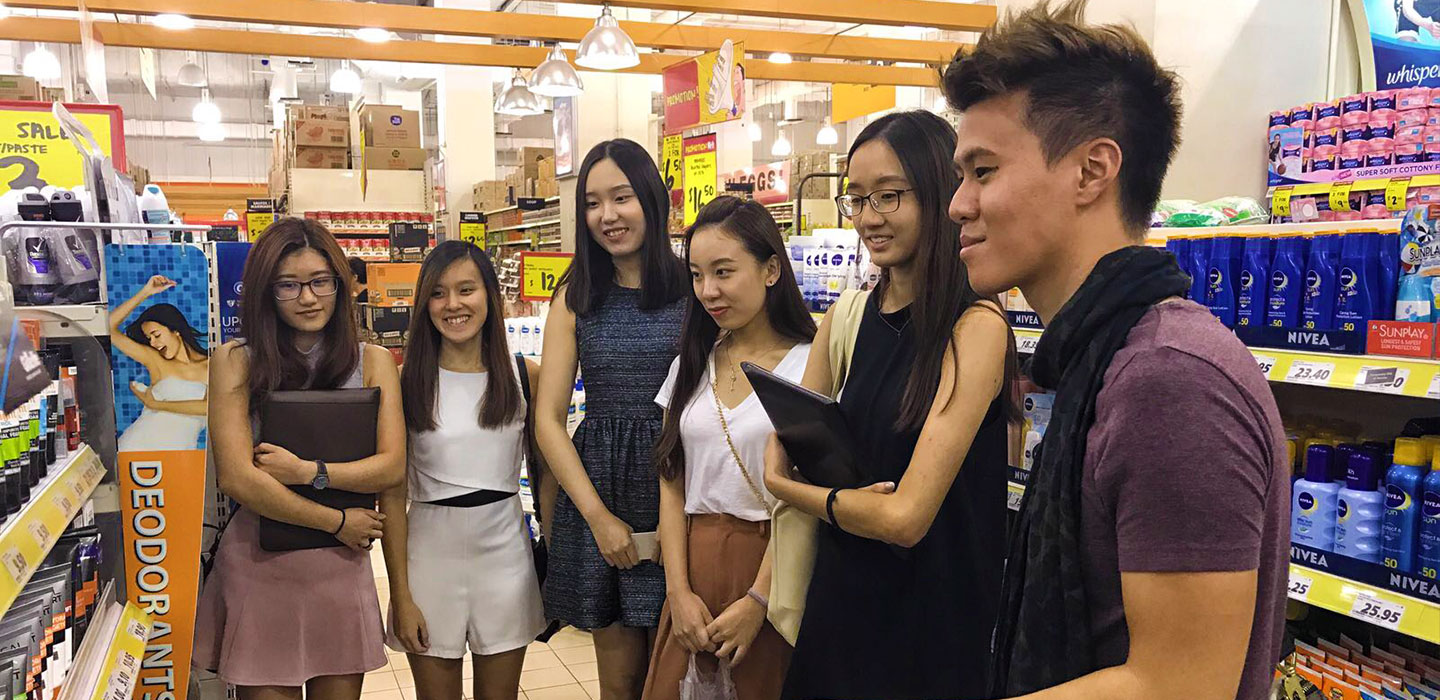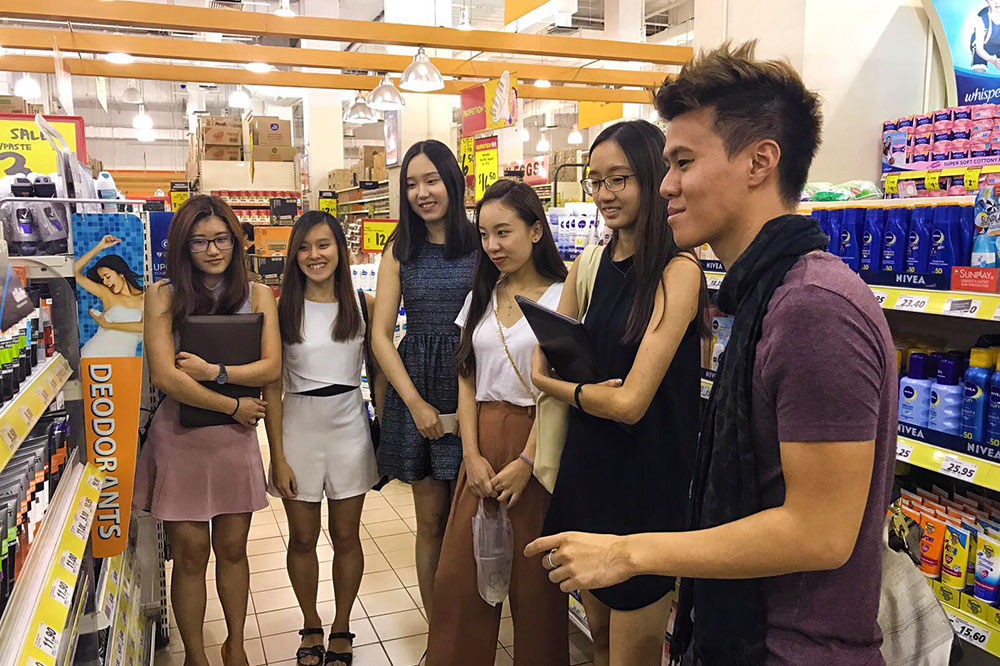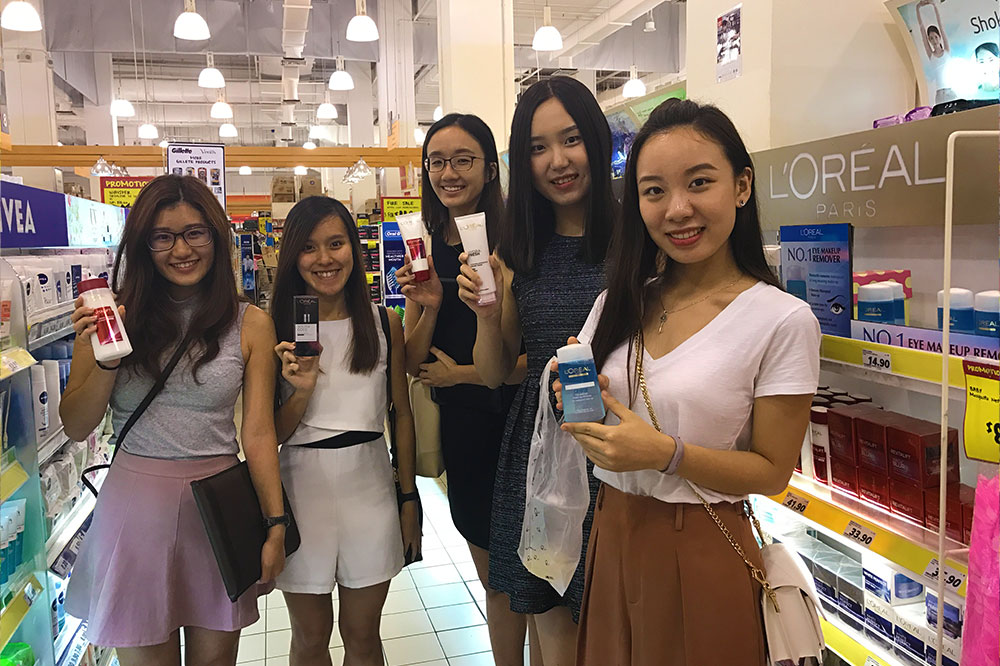Six NUS BBA year one students in the Principles of Marketing class enjoyed a 90-minutes hands-on retail tour with alumnus Andrew Tay (class of 2014) of L’Oreal at VivoCity. Andrew is in-charge of the L’Oreal Paris, managing total skincare for both female and male markets. This is the first of six corporate visits organised for students taking this module with Associate Professor Ang Swee Hoon.

Marketing students gaining knowledge at a retail walkabout

Hailing from his most recent stint at L’Oreal colour where he was previously managing hair colours, it was no surprise when Andrew greeted his juniors in a stylish blue-green coloured hair.
Right off the bat, Andrew showed us the various promotions at Guardian and the appeal each has. There’s the gondola shelving, and the retail hang strips – terms commonly used within a retail or FMCG setting. He discussed the pros and cons of these various retail promotions, and how the planning cycle goes for clusters of retail outlets that his team has to do on a monthly basis.
Andrew also explained the term “planogram” – a diagram that shows how and where specific retail products should be placed on retail shelves or displays in order to increase customer purchases. He demonstrated how as promotions change each month, details including measurement of promotion space and the arrangement of products or SKU (stock taking unit) need to be taken into consideration and executed for each retail outlet. The planogram will have to show exactly how each shelf is to be stocked. There is definitely an art to the planning and work behind what looks seemingly like a simple display at every retail outlet.
Andrew also brought up the concept of Return on Investment (ROI). Each promotion is assessed on its ROI for clusters of retail outlets so that L’Oreal learns which promotion is effective. He said, “After all the strategy and planning, advertising and social media campaigns and so on, the final battle is on the retail floor. Will consumers pick your brand off the shelf and buy it? The war is on the ground.”
Ian Khoo said having Andrew explain and answer questions was very helpful in better understanding what work is really like if you joined a FMCG. He said, “It was really enriching since Andrew touched on many aspects of marketing that are applied in the real world. While there are many technicalities in marketing, Andrew linked all these with his daily marketing activities. This insight into marketing has really satiated my curiosity beyond what is taught in the classroom.”
Next, we toured Giant hypermarket, heading to the packaged food and household items section first where the gondola shelving were much bigger than the ones at Guardian. We learnt that whenever there is a showcase of a free gift to be given away with purchase, manufacturers will package the free gift in a sturdy box so that it won’t be pilferaged!

At the personal care section, which is Andrew’s territory, he shared with how retailers determine where to place brands on the shelves – market standing as well as retail relationship are considered. So the his team needs to do loads of marketing intelligence, packed with information of competitors’ market share. The number one brand gets premium retail space which is usually the first section along the aisle. But we also learnt that sometimes the second section is better because it can catch shoppers’ attention at certain angles when they are away from the aisle. Retail relationship is also key. Sometimes, premium shelf space is afforded because the brand has excellent relations with the retailer. Andrew also enlightened us of the importance of eye-level contact and how promotional placements follow a diamond shape to captivate attention as it follows the eye movement of consumers.
At the hair colouring section, we were told that shoppers will compare the hair samples and how promoters play a key role in convincing shoppers to buy their brand. Some very good promoters can convince shoppers to buy $400 worth of personal grooming products.
“Getting to know the mindset of different brands and how they have been executed in stores is very interesting. I realised that the consciousness and psychology of the consumer affects product placement significantly,” commented Esther Tiey who had gone on the walkabout.
The final stop was Watsons where coincidentally, a Watsons employee was changing the shelves for L’Oreal with its latest promotion. And much to the delight of the students, she took out a planogram to make sure that she has placed every item as stipulated.
At the close of the trip, Jasmine Low remarked, “The walkabout was an eye-opening experience for me. Not only did I manage to grasp a better understanding of the various marketing concepts that have been taught in class and witness them being applied in real life, I was also exposed to many other interesting concepts and ideas that have yet to be taught.”
For more information on the NUS BBA programme, please visit bba.nus.edu.sg.


